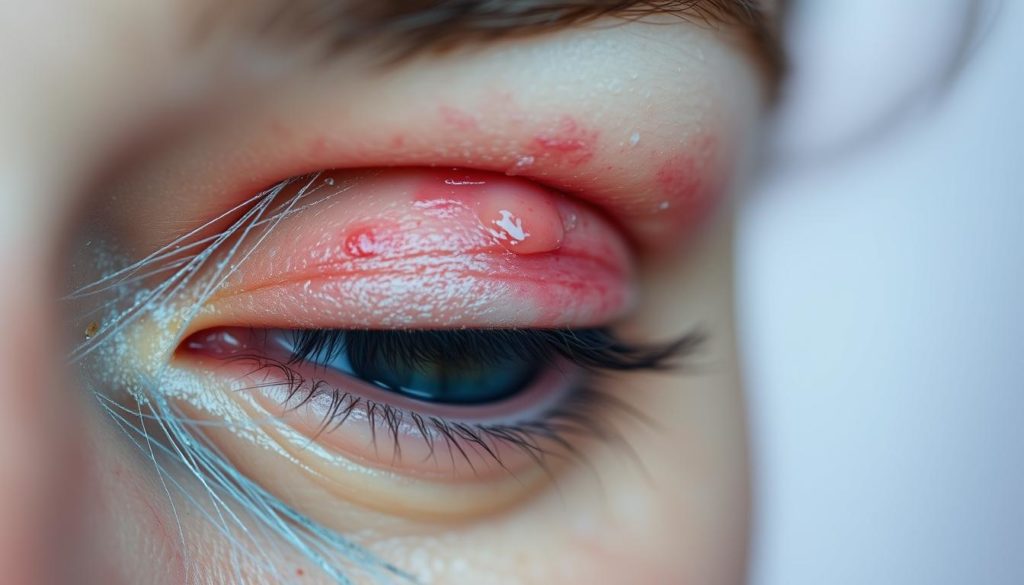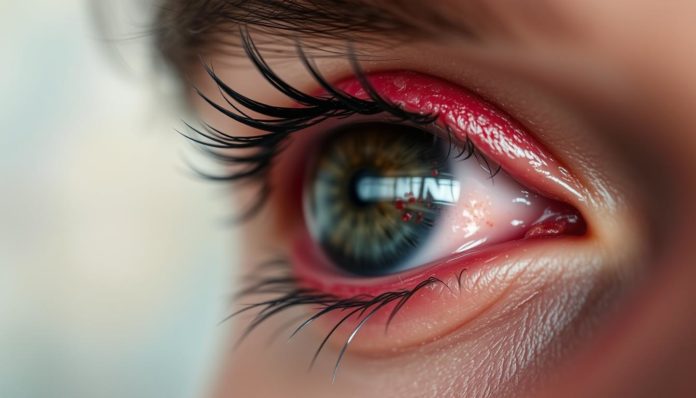Did you know nearly 37% of eye patients are diagnosed with blepharitis? This shows how common this chronic eyelid condition is. It involves eyelid swelling and usually affects both eyes. However, it doesn’t cause permanent eye damage or spread to others, but it’s tough to handle.
Waking up with symptoms like watery eyes, redness, and grittiness can be rough. Keeping clean is key in managing blepharitis. If symptoms persist, seeing a doctor is crucial. Are you ready to learn more about this eyelid inflammation? Let’s discuss its causes, how it’s identified, and the ways to treat it.
Blepharitis Overview
Blepharitis is a common eye problem. It causes chronic inflammation around the edges of the eyelids. People often wake up with greasy, crusted eyelids and a gritty feeling in their eyes. Although it’s not contagious, it usually lasts a long time. Managing blepharitis consistently is important.

Proper care is important to avoid serious issues like eyelid inflammation, dry eyes, and damage to the cornea. Keeping eyelids clean and following treatment plans are key. Without treatment, blepharitis can cause more problems for the skin around the eyes.
Below is a table summarizing some key aspects of blepharitis:
| Aspect | Details |
|---|---|
| Causes | Bacterial infections, Meibomian gland dysfunction, allergies, and skin conditions |
| Symptoms | Red, swollen eyelids, crusting, itching, and a gritty sensation |
| Complications | Dry eyes, styes, chalazia, and corneal injuries |
| Treatment | Lid hygiene, warm compresses, medications, and clinical procedures |
What is Blepharitis?
Blepharitis causes red, swollen, and itchy eyelids due to inflammation. This chronic eyelid condition might also lead to scales on the lashes. It’s important to know the types to understand the causes better.

Definition and Types
This condition splits into two kinds: anterior and posterior blepharitis. They affect different eyelid parts for various reasons.
Anterior vs. Posterior Blepharitis
Anterior blepharitis attacks the area near the eyelashes, usually due to bacteria or seborrheic dermatitis. Conversely, posterior blepharitis targets the inner eyelid part, often because of troubled Meibomian glands. Not treating either type can turn into a chronic eyelid condition.
| Type of Blepharitis | Affected Area | Common Causes |
|---|---|---|
| Anterior | Base of Eyelashes | Bacteria, Seborrhea |
| Posterior | Inner Eyelid | Meibomian Gland Dysfunction |
Common Symptoms of Blepharitis
Blepharitis is a common eye condition with various signs. Recognizing the symptoms of blepharitis is crucial for early detection and treatment. We’ll look at two main signs: eye redness with swelling, and crusting with itchiness.
Eye Redness and Swelling
Eye redness and swelling are key symptoms of blepharitis. People often feel a burning or stinging in their eyelids. They also experience increased tears and are sensitive to light.
In the morning, eyes may look puffy. This highlights the importance of recognizing these symptoms early.
Crusting and Itchiness
Crusting and itchiness around the eyes are also major signs of symptoms of blepharitis. Eyelids may feel greasy, with flaking skin at the edges. This itchiness can make people rub their eyes more, which can make things worse.
Crusting can be particularly bad when waking up. It often needs gentle cleaning to ease discomfort.
| Symptom | Description |
|---|---|
| Eye Redness | Persistent redness due to inflammation, often associated with a burning sensation. |
| Swelling | Inflammation leading to puffy eyelids, particularly noticeable in the morning. |
| Crusting | Formation of greasy deposits and crusts on the eyelids, especially after sleep. |
| Itchiness | Persistent itchiness causing frequent rubbing of the eyes, worsening the condition. |
Causes of Blepharitis
Blepharitis is marked by ongoing eyelid inflammation. It happens because of various root causes. These disrupt the balance needed for healthy eyelids and good vision. Let’s explore the main reasons for blepharitis.
Mechanical Blockages
Mechanical blockages are among the common reasons for blepharitis. Our eyelids have tiny oil glands by the lashes. These glands might get blocked by oil, debris, or dead skin cells. This leads to inflammation and irritation of the eyelids.
A big factor in this is when these oil glands don’t work right, known as Meibomian gland dysfunction. This blockage holds bacteria and oil back. It then becomes a hot spot for inflammation.
Microbial Infections
Microbial infections also play a big role in blepharitis. Bacteria, like Staphylococcus, are naturally on our skin. But if they grow too much around the eyelids, they can infect and inflame the area. Viruses and fungi might also upset the eyelids’ normal workings.
Allergies and Skin Conditions
Allergies and certain skin conditions can make eyelid inflammation worse. Things like eye makeup, pollen, or other allergens can make your eyelids swell and turn red. Skin issues like rosacea, seborrheic dermatitis, and psoriasis can also affect the eyelids. It’s crucial to manage these to keep blepharitis symptoms in check.
| Cause of Blepharitis | Details |
|---|---|
| Mechanical Blockages | Blocked oil glands due to debris and dead skin cells. |
| Microbial Infections | Overgrowth of bacteria, viruses, or fungi on the eyelids. |
| Allergies and Skin Conditions | Reactions to allergens or existing skin conditions like rosacea and dermatitis. |
Diagnosis of Blepharitis
Getting the diagnosis right is key to tackling blepharitis. Doctors start by carefully looking at the eyelids and noting symptoms.
Clinical Examination
A close look at the eyelids is the first step to diagnose blepharitis. Health experts check for redness, swelling, and lash problems. Catching these signs early is crucial for controlling blepharitis.
Diagnostic Tests
To figure out the exact cause of blepharitis, more tests might be needed. Doctors often take eyelid samples or look at eyelashes closely. They search for harmful germs or tiny mites. Identifying these causes is important for the right treatment plan.
Treatment for Blepharitis
The best treatment for blepharitis changes depending on the kind and how severe it is. Knowing the right medical care improves eye health and makes you feel better.
Medications
Medicines are key in treating blepharitis. Doctors often use antibiotic ointments or drops for bacterial infections. Steroids help lower swelling. Drugs like cyclosporine eye drops also reduce swelling by affecting the immune system.
Clinical Procedures
Many clinical treatments help with blepharitis. Techniques like Lipiflow, Intense Pulsed Light (IPL) therapy, and BlephEx improve eyelid cleanliness. They also fix issues with the meibomian glands. These methods offer a lot of relief.
| Medication Type | Purpose |
|---|---|
| Antibiotic Ointments | Combat Bacterial Infection |
| Steroids | Reduce Inflammation |
| Immunomodulators | Minimize Immune Response |
Home Remedies for Blepharitis
Managing blepharitis often combines medical treatments and home care. Home care is key to easing symptoms and managing flare-ups. Here are some helpful home remedies for blepharitis for your daily routine.
Warm Compresses
Warm compresses can ease blepharitis symptoms. They loosen crusts on eyelashes and unclog oil glands. Here’s how to use a warm compress:
- Soak a clean, soft cloth in warm water.
- Wring out the excess water.
- Place the cloth over your closed eyelids for about 5-10 minutes.
- Gently massage your eyelids to help further loosen any debris.
Lid Hygiene Practices
Proper eyelid hygiene is key for blepharitis management. Follow these steps:
- Avoid eye makeup: Eye makeup can make irritation worse. Try not wearing mascara or eyeliner for a while.
- Use baby shampoo: Mix a bit of baby shampoo with warm water. Use a cotton swab to gently clean your eyelids and lashes.
- Consider commercial lid scrubs: Try products like Ocusoft Lid Scrub for cleaning the eyelid area.
- Increase Omega-3 intake: Adding Omega-3 supplements to your diet can reduce inflammation and improve eyelid gland health.
These blepharitis home remedies can greatly better your symptoms and control this long-term condition. Regular use of these tips improves comfort and supports any prescribed treatments.
Complications from Blepharitis
Unmanaged blepharitis can lead to several secondary issues, impacting eye health greatly. It’s vital to be aware and act early to stop these complications.
Styes and Chalazia
Styes and chalazia are painful eyelid gland inflammations. A stye is an acute infection, showing up as a red, swollen bump. A chalazion happens due to blocked oil glands and is more chronic.
These complications might need medical treatment if they don’t heal by themselves.
Dry Eyes
Blepharitis inflammation can mess up your tear film, causing dry eyes. This may feel gritty and burning. It can also make wearing contact lenses hard.
To help with this, managing blepharitis well and using artificial tear solutions is recommended.
Corneal Injuries
Long-term irritation from blepharitis can cause serious issues like corneal ulcers. Such conditions can be very painful and might affect your vision.
Getting treatment fast is crucial to prevent lasting damage.
For detailed advice on blepharitis management and prevention, check out the National Center for Biotechnology Information.
Prevention of Blepharitis
To prevent blepharitis, mix daily cleaning routines with healthy eating habits. This can greatly lower the chance of getting this eye issue.
Daily Hygiene
It’s vital to keep your eyelids clean to stop blepharitis. Washing your eyelids every day removes dirt and stops bacteria from growing. Here’s what you should do:
- Use warm compresses daily to soften and loosen the debris on the eyelids.
- Gently wash your eyelids with baby shampoo to clean the area well.
- Don’t use makeup that’s expired or not yours to avoid bacterial spread.
- Make sure to take off all makeup before going to sleep to keep eyelids clean.
Dietary Considerations
What you eat is key in avoiding blepharitis. A diet full of vital nutrients can boost your eye health. Try to eat more of these:
- Omega-3 fatty acids, in fish like salmon and flaxseed, help your meibomian glands work better.
- Green leafy veggies like spinach and kale give you must-have vitamins and antioxidants.
- Stay away from high-fat foods that might increase inflammation and mess up your glands.
Keeping your eyelids clean daily and picking the right foods can help stop blepharitis. This ensures your eyes stay healthy and comfortable for a long time.
When to See a Doctor
If you have a chronic eyelid issue like blepharitis, knowing when to get medical help is key. Home remedies and eyelid care can help with mild cases. But if symptoms keep up, you might need more help.
Think about seeing an eye doctor if your blepharitis doesn’t get better with basic care. If you have ongoing redness, swelling, or itching, a specialist can help. They can figure out the exact blepharitis type and make a plan just for you.
If you suddenly have a lot of discomfort, pain, or your vision changes, get help right away. These could be signs of serious problems. Getting the right treatment for blepharitis can improve your eye health and comfort.
FAQ
What is blepharitis?
Blepharitis causes red, swollen, and itchy eyelids. It creates scales on the lashes too. It has two types: anterior and posterior, based on where the eyelid is affected.
What are the common symptoms of blepharitis?
If you have blepharitis, your eyes might water and turn red. You could feel a burning or stinging. Eyelids can get greasy, and eyelashes may crust.
Swollen eyelids and feeling like sand is in your eyes are common. Light might also bother you more.
What causes blepharitis?
Many things can spark blepharitis, like dandruff or skin issues such as rosacea. Problems with eyelid oil glands play a part. Infections, allergies, and even mites or lice on eyelashes can cause it. Dry eyes contribute too.
How is blepharitis diagnosed?
Doctors check for signs like red and swollen eyelids to diagnose blepharitis. They may test eyelid swabs for infections or mites.
What are the treatment options for blepharitis?
Treatments depend on the type and severity of blepharitis. For infections, antibiotic ointments or drops work. Steroids can reduce inflammation. Some people might need immunomodulators.
Procedures like Lipiflow, Intense Pulsed Light therapy, and BlephEx help too.
Are there any home remedies for managing blepharitis?
Yes, home remedies can help. Avoid eye makeup and use warm compresses. Omega-3 supplements are good.
Lid scrubs with baby shampoo or special products reduce dandruff and bacteria.
What complications can arise from blepharitis if left untreated?
Without treatment, you might get styes or chalazia. You could have dry eyes or tear too much. In worst cases, you risk cornea damage.
How can blepharitis be prevented?
Keep your eyelids clean and eat a balanced diet. Clean eyelids regularly and remove makeup properly. Use baby shampoo for gentle scrubs.
Eating green leafy veggies and avoiding high-fat foods helps. Omega-3 supplements also improve gland function.
When should I see a doctor for blepharitis?
See an eye doctor if cleaning doesn’t fix the symptoms. If you have severe symptoms or a lot of discomforts, get medical advice fast.


